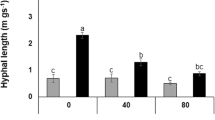Abstract
Effects of humic substances (humic acid or fulvic soil extract) or saprophytic microorganisms (Paecilomyces lilacinus and an unidentified actinomycete) on growth of mycelium and mycorrhiza formation by Glomus claroideum BEG23 were studied in a hydroponic system. Humic substances stimulated root colonization and production of extraradical mycelium by the mycorrhizal fungus. Both humic and fulvic acids tended to decrease populations of culturable bacteria and fungi in the cultivation system, indicating a moderately antibiotic activity. The addition of saprophytic microorganisms able to use humic substances to the cultivation system further stimulated the development of the mycorrhizal fungus. However, stimulation of G. claroideum was also observed when the saprophytic microorganisms were heat-killed, suggesting that their effect was not linked to a specific action on humic substances. The results indicate that humic substances may represent a stimulatory component of the soil environment with respect to arbuscular mycorrhizal fungi.


Similar content being viewed by others
References
Caris C, Hördt W, Hawkins HJ, Römheld V, George E (1998) Studies of iron transport by arbuscular hyphae from soil to peanut and sorghum plants. Mycorrhiza 8:35–39
Giovannetti M, Mosse B (1980) An evaluation of techniques for measuring vesicular arbuscular mycorrhizal infection in roots. New Phytol 84:489–500
Gryndler M, Vosátka M, Hršelová H, Chvátalová I, Jansa J (2002) Interaction between arbuscular mycorrhizal fungi and cellulose in growth substrate. Appl Soil Ecol 19:279–288
Gryndler M, Hršelová H, Klír J, Kubát J, Votruba J (2003a) Long-term fertilization affects the abundance of saprotrophic microfungi degrading resistant forms of soil organic matter. Folia Microbiol 48:76–82
Gryndler M, Jansa J, Hršelová H, Chvátalová I, Vosátka M (2003b) Chitin stimulates development and sporulation of arbuscular mycorrhizal fungi. Appl Soil Ecol 22:283–287
Linderman RG, Davis EA (2001) Vesicular–arbuscular mycorrhiza and plant growth response to soil amendment with composted grape pomace or its water extract. HortTechnology 11:446–450
Malcová R, Gryndler M, Vosátka M (2002) Magnesium ions alleviate the negative effect of manganese on Glomus claroideum BEG23. Mycorrhiza 12:125–129
Nardi S, Panuccio MR, Abenavoli MR, Muscolo A (1994) Auxin-like effects of humic substances extracted from faeces of Allolobophora caliginosa and A. rosea. Soil Biol Biochem 26:1341–1346
Nardi S, Pizzeghello D, Muscolo A, Vianello A (2002a) Physiological effects of humic substances on higher plants. Soil Biol Biochem 34:1527–1536
Nardi S, Sessi E, Pizzeghello D, Sturaro A, Rella R, Parvoli G (2002b) Biological activity of soil organic matter mobilized by root exudates. Chemosphere 46:1075–1081
Nordén M, Dabek-Zlotorzynska E (1996) Study of metal-fulvic acid interactions by capillary electrophoresis. J Chromatogr A 739:421–429
O’Donnell RW (1973) The auxin-like effects of humic preparations from leonardite. Soil Sci 116:106–112
Rydlová T, Vosátka M (2000) Sporulation of symbiotic arbuscular mycorrhizal fungi inside dead seeds of a non-host plant. Symbiosis 29:231–248
Sims JR, Haby VA (1971) Simplified colorimetric determination of soil organic matter. Soil Sci 112:137–141
Steinberg CEW, Paul A, Pflugmacher S, Thomas M, Klöcking R, Wiegand C (2003) Pure humic substances have the potential to act as xenobiotic chemicals—a review. Fresenius Environ Bull 12:391–401
St John TV, Coleman DC, Reid CPP (1983) Association of vesicular–arbuscular mycorrhizal hyphae with soil organic particles. Ecology 64:957–959
Tan HK, Nopamornbodi V (1979) Fulvic acid and the growth of the ectomycorrhizal fungus Pisolithus tinctorius. Soil Biol Biochem 11:651–653
Vallini G, Pera A, Avio L, Valdrighi M, Giovannetti M (1993) Influence of humic acids on laurel growth, associated rhizospheric microorganisms, and mycorrhizal fungi. Biol Fertil Soils 16:1–4
Visser SA (1984) Physiological action of humic substances on microbial cells. Soil Biol Biochem 17:457–462
Acknowledgements
Financial support by Grant Agency of the Czech Republic (grants 526/03/0188 and 526/00/1276) as well as institutional research concept AV0Z50200510 are gratefully acknowledged.
Author information
Authors and Affiliations
Corresponding author
Rights and permissions
About this article
Cite this article
Gryndler, M., Hršelová, H., Sudová, R. et al. Hyphal growth and mycorrhiza formation by the arbuscular mycorrhizal fungus Glomus claroideum BEG 23 is stimulated by humic substances. Mycorrhiza 15, 483–488 (2005). https://doi.org/10.1007/s00572-005-0352-7
Received:
Accepted:
Published:
Issue Date:
DOI: https://doi.org/10.1007/s00572-005-0352-7




